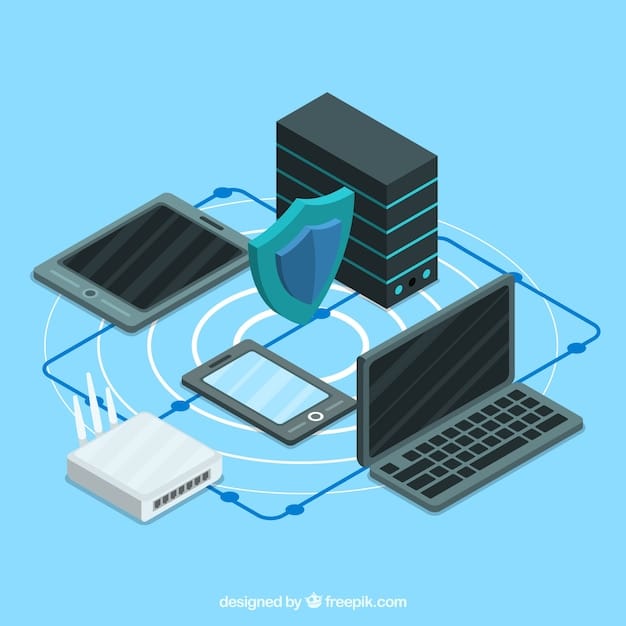Protect Your Smart Home: A Step-by-Step Guide to Secure Devices

Advertisements
Protecting your smart devices from hacking involves securing your network, using strong passwords, keeping software updated, enabling two-factor authentication, and being cautious about the apps and permissions you grant to maintain a secure smart home.
In today’s connected world, smart devices have become integral to our daily lives, offering convenience and automation. However, this increased connectivity also brings significant security risks. This guide provides a how to protect your smart devices from hacking: a step-by-step guide to help you secure your gadgets and maintain a safe digital environment.
Advertisements
Understanding the Risks to Your Smart Devices
Smart devices, ranging from smart TVs and thermostats to security cameras and voice assistants, are increasingly vulnerable to cyber threats. Understanding these risks is the first step in securing your devices. These devices are attractive targets for hackers because compromise of a single device can provide access to an entire network, potentially exposing sensitive personal information.
Common Vulnerabilities in Smart Devices
One of the primary vulnerabilities is default passwords. Many users fail to change the default passwords set by manufacturers, making it easy for attackers to gain unauthorized access. Additionally, outdated software can contain security flaws that hackers can exploit. Lack of encryption and insecure communication protocols are also common weaknesses.
Advertisements
How Hackers Exploit Smart Devices
Hackers can exploit vulnerabilities through various methods, including malware, phishing attacks, and botnets. Once a device is compromised, it can be used to spy on users, steal data, or launch attacks on other devices. For example, a compromised smart security camera could allow unauthorized individuals to monitor your home, while a hacked voice assistant could record conversations.

- Weak Passwords: Easily guessable or default passwords.
- Outdated Software: Lack of regular security updates.
- Insecure Networks: Unsecured Wi-Fi networks.
- Phishing Attacks: Tricking users into revealing sensitive information.
Recognizing these risks is vital for implementing the necessary security measures to protect your smart devices and personal information. By staying informed and proactive, you can significantly reduce the likelihood of falling victim to cyber attacks.
Securing Your Home Network: The Foundation of Smart Device Security
Your home network is the backbone of your smart home setup. Securing it is crucial for protecting all connected devices. A compromised network can provide hackers with easy access to every smart device on your network. Therefore, implementing robust security measures for your network is essential.
Strengthening Your Wi-Fi Security
Start by changing the default username and password of your Wi-Fi router. Use a strong, unique password that is difficult to guess. Enable WPA3 encryption, the latest and most secure Wi-Fi security protocol. Regularly update your router’s firmware to patch any security vulnerabilities.
Creating a Guest Network for IoT Devices
Consider creating a separate guest network for your IoT (Internet of Things) devices. This isolates your smart devices from your primary network, limiting the damage if a device is compromised. A guest network can also restrict the compromised device’s access to your personal data and other critical systems.
Furthermore, disable WPS (Wi-Fi Protected Setup) on your router, as it is often vulnerable to hacking. Use a strong firewall and regularly monitor your network for any suspicious activity. Implementing these steps can significantly enhance the security of your home network.

- Change Default Credentials: Update the default username and password immediately.
- Enable WPA3 Encryption: Provides a more secure connection.
- Update Router Firmware: Keeps your router protected against new threats.
- Monitor Network Activity: Regularly check for suspicious behavior.
By securing your home network, you create a strong foundation for protecting your smart devices and maintaining your overall digital security. Remember, a secure network is the first line of defense against potential cyber attacks.
Implementing Strong Authentication Measures
Strong authentication is an essential part of securing any smart device. Weak authentication methods, such as simple passwords or PINs, can be easily compromised by hackers. Implementing robust authentication measures significantly reduces the risk of unauthorized access and data breaches.
Using Strong, Unique Passwords
Always use strong, unique passwords for each of your smart devices. A strong password should be at least 12 characters long and include a combination of uppercase and lowercase letters, numbers, and symbols. Avoid using personal information or common words in your passwords.
Enabling Two-Factor Authentication (2FA)
Enable two-factor authentication (2FA) whenever possible. 2FA adds an extra layer of security by requiring a second form of verification, such as a code sent to your phone or an authenticator app, in addition to your password. This makes it much harder for hackers to gain access to your accounts, even if they have your password.
Password managers can help you create and store strong, unique passwords for all your accounts. They also simplify the login process by automatically filling in your credentials. Remember to regularly update your passwords and ensure all your devices are protected with strong authentication measures.
- Create Complex Passwords: Use a mix of characters for added security.
- Enable 2FA: Adds a second layer of protection.
- Use a Password Manager: Helps generate and store strong passwords.
- Regularly Update Passwords: Periodically change your passwords for enhanced security.
By implementing strong authentication measures, you significantly enhance the security of your smart devices and reduce the risk of falling victim to cyber attacks. Strong authentication is a critical step in maintaining a secure digital environment.
Keeping Software and Firmware Up to Date
Keeping the software and firmware on your smart devices up to date is crucial for maintaining their security. These updates often include patches for newly discovered security vulnerabilities. Neglecting updates can leave your devices exposed to known threats.
The Importance of Regular Updates
Software and firmware updates are regularly released by manufacturers to address security flaws and improve device performance. These updates often include critical security patches that protect against malware and other cyber threats. Regularly updating your devices ensures they are protected against the latest vulnerabilities.
How to Automate Updates
Many smart devices offer the option to automate software updates. Enable automatic updates whenever possible to ensure your devices are always running the latest software. For devices that do not support automatic updates, regularly check for updates manually and install them as soon as they are available.
Additionally, be cautious about installing updates from unofficial sources, as these may contain malware or other malicious software. Only download updates from the manufacturer’s official website or app store. Keeping your software and firmware up to date is an essential part of protecting your smart devices.
- Enable Automatic Updates: Ensures devices are always up to date.
- Regularly Check for Updates: Manually check for updates on devices without automatic updates.
- Download from Official Sources: Avoid unofficial sources that may contain malware.
- Install Updates Promptly: Apply updates as soon as they are available.
Regular software and firmware updates provide essential security enhancements and protect against emerging cyber threats. Staying proactive in updating your devices is a simple yet effective way to maintain their security.
Controlling App Permissions and Privacy Settings
Controlling app permissions and privacy settings is vital for protecting your smart devices and personal information. Many apps request access to sensitive data, such as location, contacts, and microphone. Reviewing and managing these permissions can prevent unauthorized access and privacy breaches.
Reviewing App Permissions
Regularly review the permissions granted to apps on your smart devices. Be cautious about granting unnecessary permissions, such as access to your location or contacts, unless the app genuinely requires it. Revoke permissions from apps that no longer need them or that you no longer use.
Adjusting Privacy Settings
Adjust the privacy settings on your smart devices to limit the amount of data collected and shared. Disable features like location tracking and personalized advertising if you are concerned about your privacy. Review the privacy policies of the apps and devices you use to understand how your data is being collected and used.
Furthermore, be cautious about the apps you download and install on your smart devices. Only download apps from reputable sources, such as the official app stores, and avoid installing apps from unknown or untrusted sources. Managing app permissions and privacy settings is a critical step in protecting your smart devices and personal data.
- Regularly Review Permissions: Check which permissions each app has.
- Limit Data Collection: Adjust privacy settings to minimize data sharing.
- Download from Reputable Sources: Use official app stores.
- Read Privacy Policies: Understand how your data is used.
By taking control of app permissions and privacy settings, you can reduce the risk of unauthorized access and protect your personal information. Proactive management of these settings is essential for maintaining a secure digital lifestyle.
Practicing Safe Browsing and Phishing Awareness
Safe browsing habits and phishing awareness are crucial for protecting your smart devices from malware and cyber attacks. Phishing attacks are a common method used by hackers to trick users into revealing sensitive information. Practicing safe browsing habits can significantly reduce the risk of falling victim to these attacks.
Avoiding Suspicious Links and Websites
Be cautious about clicking on links in emails, text messages, or social media posts from unknown or untrusted sources. These links may lead to phishing websites or malware downloads. Always verify the legitimacy of a website before entering any personal information.
Recognizing Phishing Attempts
Phishing attempts often involve emails or messages that appear to be from legitimate organizations, such as banks or online retailers. These messages typically request personal information, such as passwords, credit card numbers, or social security numbers. Be wary of any unsolicited requests for sensitive information and never provide it through email or text message.
Furthermore, use a reputable antivirus program and keep it updated to protect against malware and other cyber threats. Regularly scan your smart devices for viruses and other malicious software. Practicing safe browsing habits and phishing awareness can significantly reduce your risk of becoming a victim of cyber crime.
- Be Wary of Suspicious Links: Avoid clicking on unknown links.
- Recognize Phishing Emails: Identify and avoid phishing attempts.
- Use Antivirus Software: Protect devices from malware.
- Verify Website Legitimacy: Ensure websites are secure before entering information.
By adopting safe browsing practices and remaining vigilant against phishing attempts, you can safeguard your smart devices and protect your personal information from cyber threats. Awareness and caution are key to maintaining a secure digital environment.
Staying Informed and Proactive About Security
Staying informed and proactive about security is crucial for maintaining the safety of your smart devices. Cyber security threats are constantly evolving, so it is essential to keep up with the latest security news and best practices. By staying informed, you can take proactive steps to protect your devices and data.
Following Security News and Updates
Subscribe to security newsletters, follow security experts on social media, and regularly check security news websites to stay informed about the latest threats and vulnerabilities. This will help you understand the risks and take appropriate action to protect your smart devices.
Implementing a Security Routine
Establish a regular security routine for your smart devices. This routine should include tasks such as updating software, reviewing app permissions, changing passwords, and checking for suspicious activity. By making security a regular part of your routine, you can ensure your devices are always protected.
Additionally, consider investing in security software or services that can provide additional protection for your smart devices. These tools can help you detect and prevent cyber attacks, as well as monitor your network for suspicious activity. By staying informed and proactive about security, you can maintain a safe and secure digital environment.
- Subscribe to Security Newsletters: Stay updated on the latest threats.
- Follow Security Experts: Learn from industry professionals.
- Establish a Security Routine: Regularly perform security tasks.
- Invest in Security Software: Add an extra layer of protection.
Staying informed and proactive about security is an ongoing process. By continuously learning and adapting to new threats, you can ensure your smart devices and personal information remain protected.
| Key Point | Brief Description |
|---|---|
| 🛡️ Secure Network | Protect your Wi-Fi with strong encryption and passwords. |
| 🔒 Strong Passwords | Use unique, complex passwords and a password manager. |
| 🔄 Regular Updates | Keep software and firmware updated for security patches. |
| ⚠️ App Permissions | Review and control app permissions to protect your privacy. |
FAQ: Protecting Your Smart Devices
Why are smart devices vulnerable to hacking?
▼
Smart devices are vulnerable due to weak default security settings, outdated software, and the potential for insecure network connections. These vulnerabilities can be exploited by hackers to gain unauthorized access.
▼
Smart devices are vulnerable due to weak default security settings, outdated software, and the potential for insecure network connections. These vulnerabilities can be exploited by hackers to gain unauthorized access.
▼
Create strong passwords by using a combination of uppercase and lowercase letters, numbers, and symbols. Avoid using personal information or common words. Use a password manager to generate and store your passwords securely.
▼
Two-factor authentication (2FA) adds an extra layer of security by requiring a second form of verification, such as a code sent to your phone. This makes it harder for hackers to access your accounts, even if they have your password.
▼
You should update the software on your smart devices as soon as updates are available. These updates often include critical security patches that protect against the latest cyber threats. Enable automatic updates whenever possible.
▼
If you suspect your smart device has been hacked, immediately disconnect it from the internet. Change all passwords associated with the device and related accounts. Run a virus scan and contact a security professional for further assistance.
Conclusion
Protecting your smart devices from hacking requires a proactive and comprehensive approach. By securing your network, implementing strong authentication measures, keeping software updated, controlling app permissions, and practicing safe browsing habits, you can significantly reduce your risk of becoming a victim of cyber attacks. Stay informed and make security a priority to maintain a safe and secure digital environment.